
de Gasparis is a lunar crater that is located in the southwest part of the Moon. It lies to the southeast of the crater Cavendish and south of Mersenius.

Agatharchides is a lunar impact crater located at the southern edge of Oceanus Procellarum, in the region between the Mare Humorum and Mare Nubium. To the east-southeast is the crater Bullialdus, and to the south-southwest lies Loewy. It is named after the Greek geographer Agatharchides.

Barrow is an old lunar impact crater that is located near the northern limb of the Moon. It lies between the crater Goldschmidt to the northwest and the irregular formation Meton to the northeast. To the southwest is W. Bond.

Belʹkovich is a large lunar impact crater of the form termed a walled plain. The formation has been heavily eroded by a history of subsequent impacts, leaving it reshaped, worn, and the features softened and rounded. Belʹkovich is located along the northeastern limb of the Moon, and so its visibility is subject to libration effects. From the Earth this crater is viewed from the side, making it difficult to view it in detail.

Chamberlin is a lunar impact crater that is located on the far side of the Moon, just past the southeastern limb. It lies to the southeast of the crater Jeans, and Moulton is attached to the southeastern rim of Chamberlin. This crater is located in a part of the lunar surface that has undergone resurfacing of crater interiors, producing dark-hued crater floors.
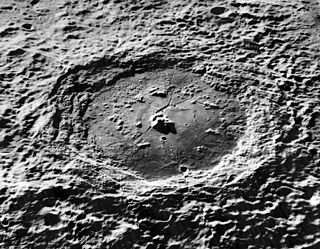
Compton is a prominent lunar impact crater that is located in the northern hemisphere on the far side of the Moon. It lies to the east of the Mare Humboldtianum, and southwest of the walled plain Schwarzschild. To the southeast of Compton is the heavily eroded crater Swann.
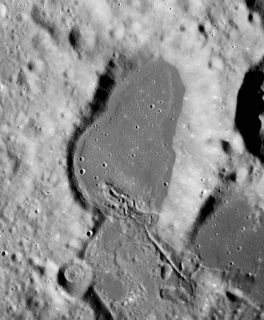
Bowditch is a lunar impact crater that lies on the far side of the Moon, just beyond the eastern limb. It is located on a region of the lunar surface that is brought into view due to libration, but at such times the area is viewed from the edge and so not much detail can be observed. It lies just to the north of the small Lacus Solitudinis lunar mare, between the craters Titius to the southwest and Perel'man to the east-northeast.
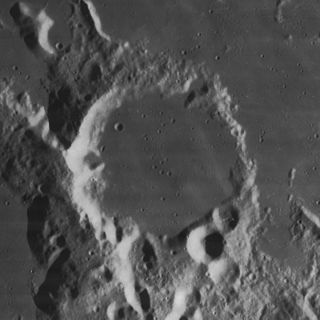
Capuanus is a lunar impact crater that lies along the southern edge of the Palus Epidemiarum. It was named after Italian astronomer F. Capuano di Manfredonia. The outer rim is eroded and indented by lesser crater impacts, with notches in the north, west, and southern parts of the rim. The interior floor has been resurfaced by basaltic lava, which is connected to the surrounding lunar mare by a narrow, crater-formed gap in the northern rim. Dotting the floor of the crater are a number of domes, which are believed to have formed through volcanic activity.

Casatus is a lunar impact crater that is located near the southern limb of the Moon. The north-northeast rim of the crater overlies a portion of the slightly larger crater Klaproth. Along the western rim, Casatus A intrudes somewhat into the interior, producing an inward-bowing rim. To the southeast of Casatus is Newton.

Rayleigh is a lunar impact crater, approximately 114 kilometers in diameter, that lies along the northeast limb of the Moon. This feature is seen edge-on from Earth, making it difficult to see much detail. In addition, libration effects can completely hide this crater from view. It lies just to the north of Lyapunov, and to the northwest of the large Joliot. Attached to its southwest rim is the smaller Urey.
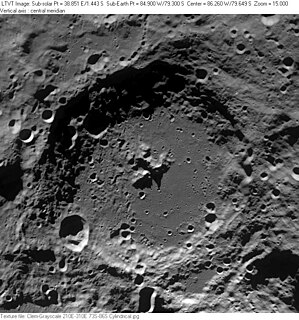
Drygalski is a large lunar impact crater that lies along the southern limb of the Moon. It partly overlies the crater Ashbrook to the west on the far side of the Moon. Just to the north of Drygalski is the smaller Boltzmann. The location of this crater restricts its observation from the Earth, and even under conditions of favorable libration it is viewed from the edge. It is only illuminated by the Sun at an oblique angle, and it lies close to the south polar craters that are permanently shielded from sunlight.

Xenophanes is a lunar impact crater that is located along the northwestern limb of the Moon. It is nearly attached to Volta, a similar formation to the south-southwest. To the northeast is the smaller crater Cleostratus. Xenophanes is significantly foreshortened when viewed from the Earth, hindering observation.

Pascal is a lunar impact crater that lies near the northern limb of the Moon, on the western side of the pole. It is located to the north of the eroded crater Desargues, and just east of Brianchon. Pascal can be located by finding the crater Carpenter and then following the surface to the northwest towards the limb. However the visibility of this formation can be affected by libration.

Chrétien is a lunar impact crater that is located in the southern hemisphere on the far side of the Moon from the Earth. It lies due south of the Mare Ingenii, one of the few maria on the Moon's far side. The crater lies in the midpoint between the craters Garavito to the west-southwest and Oresme to the east-northeast, both of these being somewhat smaller than Chrétien.

d'Alembert is a large lunar impact crater located in the northern hemisphere on the far side of the Moon, to the northeast of the somewhat smaller walled plain Campbell. Astride the southwest rim of d'Alembert is Slipher. To the north is the crater Yamamoto, and to the south-southwest lies Langevin. This walled plain has the same diameter as Clavius on the near side, making it one of the largest such formations on the Moon.

Hubble is a lunar impact crater that lies very near the east-northeastern limb of the Moon. At this location it is viewed almost from the side from Earth, and the visibility of this feature is affected by libration. It lies to the north of the Mare Marginis and northeast of the crater Cannon. About one crater diameter to the north-northeast is Lyapunov.
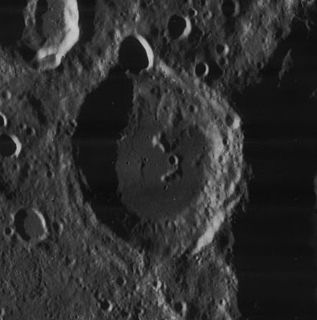
Lyapunov is a lunar impact crater named for Aleksandr Lyapunov that is located along the east-northeastern limb of the Moon, and is viewed from the side by observers on Earth. The eastern rim of this crater just falls into the section of the Moon called the far side, and visibility of this formation is affected by libration.

Palmieri is a lunar impact crater that lies to the southwest of the Mare Humorum, in the southwestern quadrant of the Moon's near side. It lies due south of the crater Liebig and east-northeast of the larger Fourier.

Edison is a lunar impact crater on the far side of the Moon. It is located just behind the north-northeastern limb of the Moon, a region that is sometimes brought into sight from Earth during favorable librations. However even at such times not much detail can be discerned, and the crater is better observed by orbiting spacecraft.
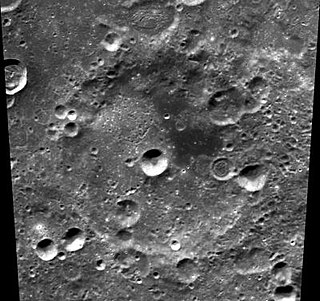
Minkowski is a crater on the far side of the Moon, in the lower latitudes of the southern hemisphere. The lunar crater lies about one crater diameter to the north-northeast of crater Lemaître, a formation of similar dimension. To the northwest of Minkowski is the flooded crater Baldet, and to the southeast lies Fizeau.





















